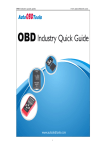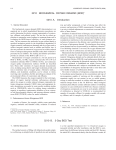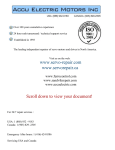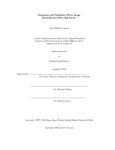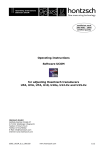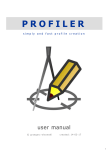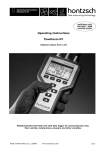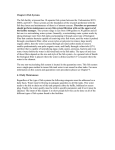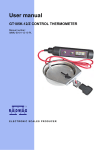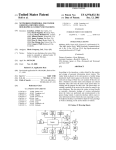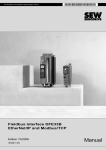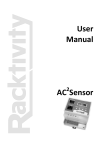Download Manual Swim-5 - Loligo Systems
Transcript
SWIM-5 USER MANUAL A. List of parts ü ü ü ü ü ü ü Swim tunnel respirometer in buffer tank One main lid and two test section lids Short PVC base and long with motor mount Flush (respirometer) and mixing (buffer tank) pump Motor frequency converter with analog input and output Spare parts, tubing, tools and plastic fittings User manual B. Installation DO NOT use the propeller shaft for lifting the swim tunnel out of the wooden crate and/opr buffer tank, since this may break acrylic parts housing shaft bearings and seals. Place the buffer tank on top of the two grey PVC bases and on a firm and levels surface supporting the weight of the entire set up including water. Mount the motor on the longer of the two bases, using the acrylic sheets packed with the screws. Make sure that the two shaft coupling parts come together fully aligned. Connect the motor cable to the speed control box, and secure by using the connector clamp. Finally connect the power cord a grounded wall plug outlet using the power cord. IMPORTANT: DO NOT RUN THE MOTOR WITHOUT WATER IN THE SYSTEMS! During operation the buffer and respirometer tank should allways be filled with water to above the level of the shaft, bearings and seals for proper lubraction! The mechanical shaft seals will be destroyed within minutes of operation even at low speeds if running while dry! Lids There is one large main respiromete lid and two smaller ones for the test section, e.g. one for measuring oxygen consumptions in a closed respirometer volume; and one with a circular insert for a flow probe. The latter is not sealed for oxygen consumption measurements. Remember to secure the large main lid with ALL the wing nuts and washers, tightening the nuts in a gradual way. The large hose fitting in the main lid is where water leaves the respirometer while flushing the chamber with the submersible “flush” pump. At high water velocities the water level might raise and spill due to increased pressure. To avoid this, simply place a piece of stiff tubing on the hose fittings to prevent water from leaving the respirometer during MO2 measurements. The main lid also has two probe ports, e.g. one for an oxygen probe and one for a temperature probe. Fittings Mount the plastic T-piece and hose fitting on the over flow in the buffer tank, allowing excess water to leave the system. For long-term experiments, we recommend to replenish water by adding a continuous flow of purified system water to the ambient tank, and to connect the overflow hose to a drain. Alternatively, place a pump sump below the buffer tank and return the water through a flowthrough UV sterilizer and a biofilter with activated charcoal using a pump. Flush pump In order to avoid oxygen depletion and metabolites building up due to animal respiration inside the closed swim tunnel respirometer, the volume of water should frequently be flushed/replenished. For this purpose, place the submersible flush pump in the buffer tank and connect it with a piece of tubing to the hose fitting near the propeller. The flush pump should always be powerfull enough to pump water in and out through the large hose fitting in the main lid! Heat exchanger The swim tunnel respirometer has a build-in stainless heat exchanger opposite the test section, for accurate control of the water temperature inside. When the chamber is closed (ie. flush pump inactive), water temperatures might slowly increase due to friction forces created by the turning propeller. In most cases this effect is neglible and temperature control of the ambient water in the surrounding buffer tank is adequate. However, to compensate for any significant temperatures changes during measuring periods, use a REG or DAQ instrument for measuring water temperatures inside the chamber continuously, and for automated activation/deactivation of a pump passing chilled water through the heat-exchanger. In this way experimental water temperature can be regulated accurately and continuously to set point values. C. Frequency converter Operation Turn the main switch clockwise to power the motor – this require some force to avoid accidents from happening. Slowly turn the upper most speed knob clockwise to increase water velocity inside the swim tunnel respirometer. From the digital display the number of shaft revolutions per minute (RPM) can be monitored. Use the forward-0-reverse knob to change direction of flow. Analog output Use wires 8 (+) and 9 (0) to pick up a 0-10VDC linear analog output from the frequency converter. This output can be connected to one of our DAQ instruments to monitor and record water velocities and solid blocking corrected swim speeds in real-time via a PC. Analog input Use wires 6 (+) and 7 (0) to control motor speed using a 0-10VDC input, e.g. from a D/A PC device or similar. To over ride the manual speed knob, switch the large lower knob to position “PC”. For further instructions on the motor frequency converter, please refer to the MOVITRAC user manual. D. Calibration Respirometer volume For respirometric measurements, it is important to determine the exact volume of the swim tunnel respirometer. This is easily done by filling the swim tunnel respirometer completely (do not fill any water in the ambient tank) with all ports sealed/blocked. Make sure to get rid of all air bubbles. Finally empty all the water into a measuring beaker or weigh the entire swim tunnel respirometer with and without water to determine the volume. Flow velocity Optional flow measuring equipment is required for flow velocity calibrations. We strongly recommend using the 30mm vane wheel flow probe and digital anemometer from Höntzsch (AC10000). Alternatively, use dye techniques, DPIV or laser doppler equipment. Start flow calibrating the swim respirometer by filling it completely with water, (no air bubbles) and make sure that all wing nuts are firmly tighten. Then record the analog output from the motor frequency converter or the RPM readings on the display as water velocity increase stepwise. For each of 5-10 steps, record the DC output or RPM versus measured flow velocity. In this way a linear relationship between the output (RPM or DC signal) and water velocity can be established. From this relationship, water velocity can be adjusted during experiments without the need for simultaneous flow measurements.Make sure to perform a new flow calibration if the swim tunnel is moved or modified in any way. Adjusting flow The swim tunnel design allows for modification of the flow profile inside the test section. This is usually not necessary, but might be usefull to fit different experimental purposes, i.e. reducingeliminating wall effects on fish swimming behaviour by means of high flows near walls and low flows in the centre of the test section. Changing the sideway position of the adjustable vanes (next to the honeycomb material), will redistribute water flows in the test section. Start by removing the main lid, then carefully lift out the half circle shaped section holding the vanes. Take the center vane out and then the two adjustable ones. Change the sideway position of one or both vanes, by tiny adjustments of the screw holding the vane in the slot. Reassemble and check the flow profile with a flow probe or flow visualization technique. It might be necessary to perform the operation several times in order to get the proper results. E. Maintenance The swim tunnel is designed for effortless maintenance and easy cleaning. Thus, all inner parts are detachable and can be taken out for cleaning or repairs. To remove the swim respirometer from the buffer tank, unscrew the four corner wing nuts holding it in place. Then turn the submerged shaft coupling to a position allowing you to lift the respirometer up and out. Cleaning The swim tunnel respirometer are made of non-corroding parts. However, we recommend frequently rinsing the entire swim tunnel and buffer tank with tap water and wiping it dry, to avoid problems with corrosion, or biofilm on surfaces. If necessary use a mild detergent to remove dirt. The swim tunnel is made mianly of acrylic materials (PMMA) due to its fine optical and mechanical properties, and high resistance to UV-radiation. However, PMMA is NOT to be used with most dissolvent, especially not polar, i.e. gasoline, concentrated acids or alcohol. IMPORTANT: DO NOT USE ALCOHOL ON ANY ACRYLIC SURFACES – IT WILL CAUSE CRACKS! Prop shaft bearings and seals Even though the moving part (shaft bearings and spring loaded mechanical seals) of the swim tunnel are made of high quality stainless materials and glass bearings, they may require service or replacement after extended operation. To remove the shaft and service/replace parts, detach the shaft coupling parts using the small hexagonal wrench and take the swim tunnel out of the buffer tank. Unscrew both plastic housings holding the bearings and pull out the shaft from within the swim tunnel. Contact us for more details. F. Tips & Tricks Through years of research experience we have learned a few tricks that might help you through swim tunnel experiments and avoid problems associated with physiological stress and animal behaviour. Handling stress Handling stress can affect the metabolism of experimental animals for several hours! For instance, oxygen consumption rates of fish often increase by an order of magnitude following initial handling (netting, weighing etc.). Thus, minimize handling and allow fish time to recover (>5 hours) from any initial stressors while swimming at slow speeds (1/3-1/2 body lengths per second). Other stressors While inside the swim tunnel, animals still respond to external stimuli from experimenters and lab surroundings. It is therefore a good idea to isolate the swim tunnel behind shades, and monitor the fish from a distance using a video camera. Swimming behaviour Intra- and interspecific variations in swimming mode and behaviour, frequently challenge experimenters and the odd specimen will not perform steady swimming even after several trials. However, if a specimen refuses to swim steady in the test section, even at low speeds, try to provide the fish with some visual cues to help it keep stationary in the swim tunnel. We recommend a few vertical strips of coloured adhesive tape on the walls of the upstream part of the working section. If an animal rests at the downstream grid, perhaps tail against the current, turn the motor off, reverse the direction of flow, and slowly increase the flow until the fish is carried away from the grid. When the animal faces upstream, turn the motor off, reverse the direction of flow and increase the speed slowly. Repeat this procedure several times if necessary. One of several other ways to avoid experimental animals taking up positions at the rear, is to create a dark refuge in the upstream part of the test section and an exposed downstream part mounting a strong light source over the grid, e.g. this will often make the fish start swimming in an upstream position avoiding the exposed part of the test section.




